GLP-1 receptor agonists, medications like Ozempic, Wegovy, Mounjaro, and Zepbound, are increasingly prescribed for obesity and diabetes. However, recent reports suggest a possible link between these drugs and certain eye conditions. A new study adds to this growing concern, detailing cases of vision complications potentially associated with GLP-1 drug use. While these cases don’t definitively prove causation, they highlight the need for further investigation.
Recent research has hinted at a connection between GLP-1 drugs and eye problems. A study published last summer found an increased risk of nonarteritic anterior ischemic optic neuropathy (NAION) in patients using semaglutide. NAION is a rare condition resulting from reduced blood flow to the optic nerve. Following this and other similar findings, Danish health officials urged the European Union to investigate the potential link between GLP-1 drugs and NAION.
A new case series published in JAMA Ophthalmology presents nine cases of vision complications potentially linked to GLP-1 drugs. Seven cases involved NAION following GLP-1 drug initiation, one involved papillitis (optic nerve inflammation), and another involved paracentral acute middle maculopathy (blood vessel damage in the macula, the retina’s central area). In several instances, vision improved or stabilized after discontinuing the medication, although some patients continued treatment without lasting issues.
The researchers emphasize that these cases don’t confirm a causal relationship between GLP-1 drugs and these eye complications. The majority of individuals in the study had pre-existing type 2 diabetes, a condition characterized by elevated blood sugar. The researchers suggest that the rapid blood sugar reduction caused by GLP-1 drugs might indirectly contribute to some of these eye issues, rather than a direct toxic effect of the medication. Papillitis has been associated with rapid drops in blood sugar, and the researchers speculate this could also be true for some NAION cases.
However, other factors might be at play. GLP-1 receptors are present in some optic nerve cells, suggesting another pathway for these drugs to potentially impact eye function. Further research is needed to fully understand this potential link.
Despite NAION’s rarity, even a slight increase in risk could affect a significant number of people due to the growing popularity of GLP-1 drugs. Understanding the mechanisms behind this potential connection could lead to improved patient care. If rapid blood glucose reduction is a contributing factor, as the researchers suspect, adjusting treatment plans for high-risk patients could help prevent future complications. Typically, GLP-1 therapy involves gradually increasing doses over time. A slower approach might be beneficial for certain individuals.
The researchers also hope their findings raise awareness among ophthalmologists about this potential link. Continued research is crucial to test this hypothesis and ensure effective communication between doctors and patients regarding GLP-1 drug use. As Dr. Bradley Katz, a neuro-ophthalmologist at the University of Utah’s John A. Moran Eye Center, states, “Further studies are needed… However, this is an important issue for ophthalmologists as we monitor usage of these drugs and how to best be in communication with our patients about them.”










